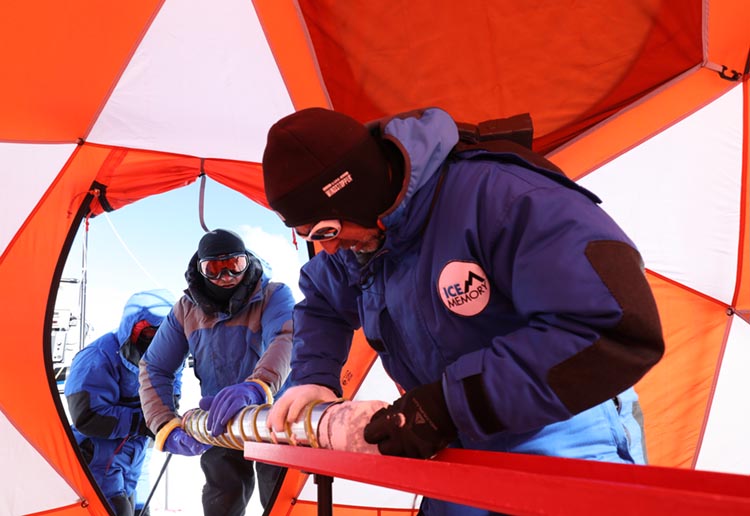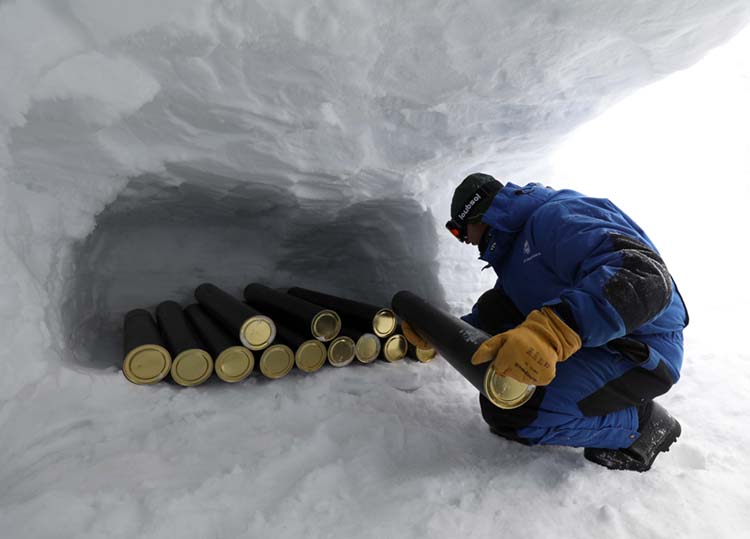On June 6, 2017, the Ice Memory team drills near their camp on the Illimani glacier in the Andes Mountains of Bolivia. Credit: © Sarah Del Ben, Wiltouch/Fondation UGA
Last month, in June, an international team of researchers and scientists braved heavy snows, freezing winds, and thin air to extract ice core samples from the Illimani glacier high in the Andes Mountains of Bolivia. The samples were the latest collected by teams from Ice Memory, a project aiming to gather ice samples from endangered glaciers around the world. The archive—which will be stored in a sanctuary in Antarctica—will allow future studies of glaciers that will soon fall victim to global warming. Ice Memory is managed by the University of Grenoble Alps Foundation in France and supported by the French and Italian national commissions for the United NationsEducational, Scientific and Cultural Organization (UNESCO).
At 21,004 feet (6,402 meters), Illimani is the highest mountain in the Cordillera Real range of eastern Bolivia. Glaciers on Illimani have existed for many thousands of years, but they are rapidly melting and retreating as
climate change increases
Earth’s temperatures. Glacier ice reads like a historical record of climate and environment, preserving ancient animal, plant, and mineral samples as well as showing glacial growth over millennia. They also show variations in temperatures and more recent concentrations of
greenhouse gases and other
pollutants. Saving Illimani cores will allow scientists to study the ice long after the host glaciers have disappeared.

Scientists remove ice from the drilling core on the Illimani glacier in Bolivia on June 9, 2017. Credit: © Sarah Del Ben, Wiltouch/Fondation UGA
It took several weeks for the Illimani team to drill through the ice and extract the core samples, both of which were more than 440 feet (135 meters) long. Dangerous weather forced the team to abandon the planned retrieval of a third sample. The glacier cores were then cut into smaller pieces, stored in tubes, and catalogued. The samples will eventually make their way to the archive at Concordia Station in Antarctica, where they will join the first core samples extracted from France’s Mont Blancin 2016. The Concordia glacier archive is meant to store hundreds of ice core samples in a protected snow cave at -65° Fahrenheit (-54° Celsius).

An Ice Memory researcher stacks tubed sections of ice core in an improvised snow cave on the Illimani glacier on June 5, 2017. The samples will eventually be stored in Antarctica. Credit: © Sarah Del Ben, Wiltouch/Fondation UGA
Future core extractions are planned for such threatened glacier areas as Mera Peak in Nepal, Mount Elbrus in Russia, Mount Kilimanjaro in Tanzania, and sites in the Swiss Alps and the Altai Mountains in Asia. Ideally, three glacier samples from each area will provide one sample for immediate analysis and two for storage and archiving. Aside from providing clues about the past, the samples help scientists understand the current effects of climate change and predict future environmental events.
Untitled Document Can't view the linked articles? Subscribe to World Book Online

World Book Online delivers a progressive sequence of core databases supported by supplemental
tools, such as language translation, graphic organizers, and unique Webquests. Moving from
Early World of Learning to World Book Advanced, World Book Online aligns end-users with their
appropriate learning levels. Each stand-alone site provides additional features to support the
needs of users’ specific capabilities.
The World Book Difference
World Book combines cutting-edge technology with traditional editorial excellence to produce
authoritative, trustworthy, and unbiased content. The digital content is updated in real time and
carefully curated for each learning level. Accessible 24/7, the content is available on a variety of devices.
World Book Online combines 21st-century instructional techniques with timely information.
By breaking down complex topics and using easily understandable text, World Book Online helps to
build fluency and increase comprehension. Featuring single sign-on capability, these sites are paired
with highly visual content to engage even the most reluctant reader. Our collection of resources kindles
a lifelong learning experience for every user. This adherence to clarity, currency, and accuracy makes
World Book’s digital offerings an information hub for the classroom, library, and beyond.